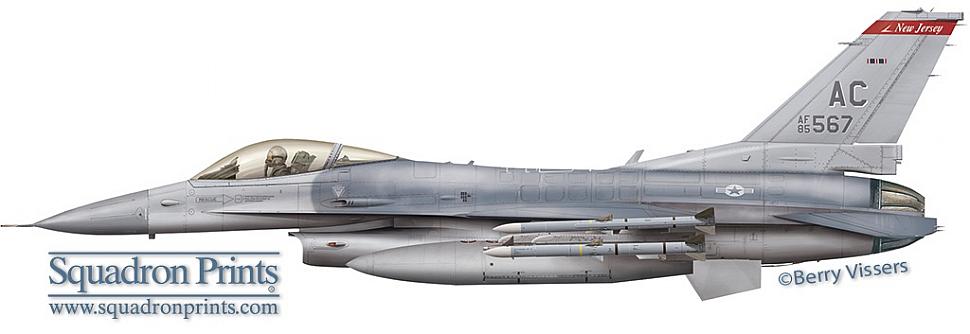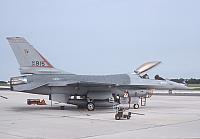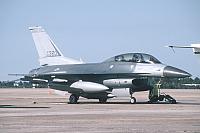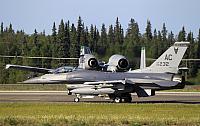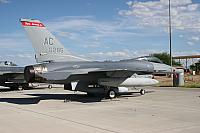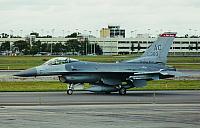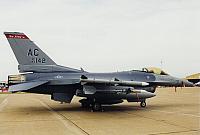 |
119th Fighter Squadron ( USAF ANG)" Jersey Devils" |
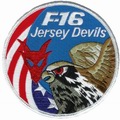 |
119 FS " Jersey Devils" ( USAF ANG) | |||
| Status: |
Active
|
|||
| Version: | F-16C/D block 30 | |||
| Role: | Air Defence, Attack | |||
| Tailband: | Red | |||
| Motto: | N/A | |||
| Badge: | N/A | |||
F-16 History
In July of 1988 the squadron started receiving their first F-16s. These were of the block 15 type, replacing the venerable F-106 in the air defense role. Since this was the primary role of the unit, it was decided to upgrade these airframes with the Air Defense Fighter (ADF) option. This featured the addition of a CWI module on the APG-66 radar, a search light on the port side of the nose, more adapted communication equipment, an Advanced Identification Friend or Foe (AIFF) system and the possibility to fire AIM-7 or the later AIM-120 missiles. The upgrade happened in November of 1990. To that date the unit also flew some F-106s aside the F-16. The 119th FS was the last USAF unit to withdraw the F-106 from operational duty.
In 1994 the squadron started trading in their ADF version of the viper for the more advanced block 25 version. The ADF A/B models were being retired and sent to the boneyard at AMARG, only flying for a mere 4 years in that configuration with still a lot of hours left on those airframes.
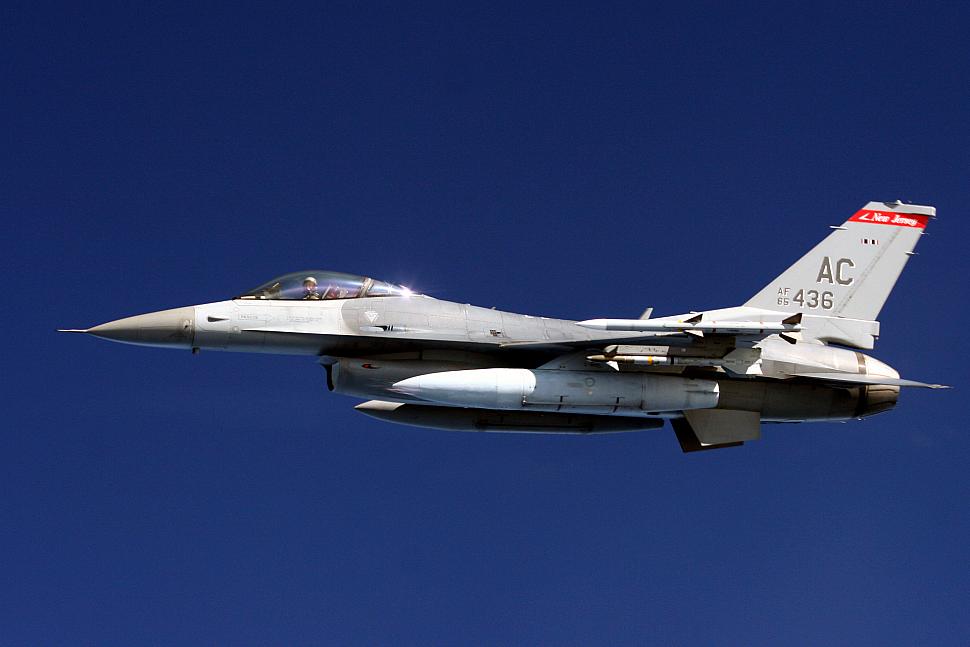
As a result of the attacks on the United States on September 11th, 2001 the 119th FS found itself in a key position. Located between New York and Washington DC, the 119th was immediately tasked with providing combat air patrols over cities in its region. In fact three aircraft were scrambled to intercept the aircraft that impacted the pentagon, but were too late. They were then vectored to intercept flight 93 which eventually crashed in Pennsylvania. Although these three pilots did not know it at the time they would have been given authorization to down the airliners once intercepted. Following the attacks on that fateful day, the 119th FS began flying missions for Operation Noble Eagle. On July 12th, 2002 the squadron flew it's 1000 mission for Operation Nobel Eagle. From that year they also started to contribute in other overseas contingency operations.
In September of 2007 the first USAF F-16Cs to be retired to AMARG were from the 119th FS who sent two to the desert boneyard. In replacement for the ageing block 25s were the not much newer block 30s. During this transition the mission of the squadron remained. This being a double task as an air defense squadron in the northern section of the US and as a multirole squadron to carry out contingency operations abroad.
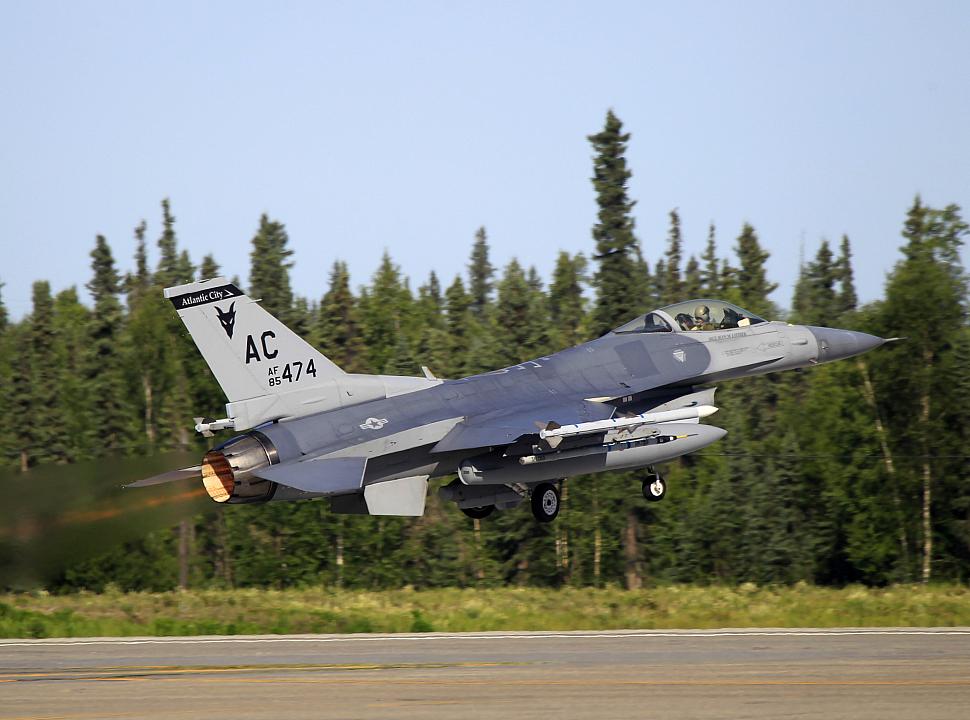
Aircraft Markings History
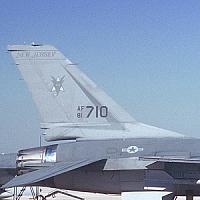
Similar markings carried over from the F-106 but low-viz. An arrow pointing forward and down on the leading end of the tail and tailbase. The tailband consists of the state name 'New Jersey'. Unlike the F-106, a silouette of the devil face was added to the middle of the tail with the serial number underneath it.
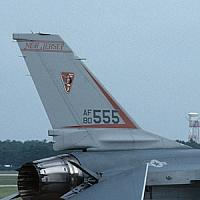
The silouette of the devil face was removed in favour of the squadron friday badge which was worn on the ADF version. The toned-down markings were also dropped being replaced by red ones.

With the introduction of the C/D models the squadron reverted back to the old-school low-viz markings with a slightly changed design of the arrow. The tailband was the base name 'Atlantic City' and the serial was at the bottom of the tail. This scheme was only worn very briefly.

Soon after the previous design the 'AC' tailcode - for Atlantic City - was introduced. The large arrow was shrunk and moved up into the tailband that became sold either grey or red with white 'New Jersey' titles included. The serial number was at the bottom of the tail.

Unit History
- 1917: Activation of the squadron in Hampton, Virginia (as 5 ASS)
- 1917: BT-1 (Langley Field, Virginia)
- 1917: O-17 (redesignated 119 AS)
- 1918: O-2
- 1919: Disbanded
- 1930: Activation of the squadron in Newark, New Jersey
- 1930: BC-1A (part of 44 D)
- 1934: O-46
- 1939: O-47
- 1941: O-47 (part of 59 OG)
- 1942: O-47 (Fort Dix AAB, New Jersey)
- 1942: O-47 (Barnstable AP, Massachusetts)
- 1942: O-47 (Grenier Field, New Hampshire)
- 1942: O-47 (Birmingham Field, Alabama)
- 1942: Deactivated
- 1943: Activation of the squadron in Page, Florida
- 1943: P-39 'Airacobra' (part of 59 RG)
- 1943: P-39 'Airacobra' (Thomasville Field, Georgia)
- 1943: P-39 'Airacobra' (redesignated as 490 FS)
- 1944: Disbanded
- 1946: Activation of the squadron in Newark, New Jersey (as 119 FS)
- 1946: P-47D 'Thunderbolt' (part of 177 FG)
- 1952: P-51H 'Mustang'
- 1954: P-51D 'Mustang'
- 1955: F-86E 'Sabre'
- 1958: F-84F 'Thunderstreak' (Atlantic City NAS, New Jersey)
- 1961: F-84F 'Thunderstreak' (part of 7108 TFW, Chaumont AB [Fr.])
- 1962: F-86H 'Sabre' (part of 177 TFG, Atlantic City NAS, New Jersey)
- 1964: F-100C 'Super Sabre'
- 1968: F-100C 'Super Sabre' (part of 113 TFW, Myrtle Beach AFB, South Carolina)
- 1969: F-100C 'Super Sabre' (part of 177 FG, Atlantic City NAS, New Jersey)
- 1970: F-105B 'Thunderchief'
- 1972: F-105B 'Thunderchief' (part of 177 FIG)
- 1973: F-106A/B 'Delta Dart'
- 1988: F-16A/B 'Fighting Falcon' (part of 177 TFW)
- 1992: F-16A/B 'Fighting Falcon' (part of 177 FG)
- 1994: F-16C/D 'Fighting Falcon'
- 1995: F-16C/D 'Fighting Falcon' (part of 177 FW)
Deployments
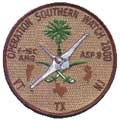 |
' Southern Watch' |
| Prince Sultan AB, Saudi Arabia [2 F-16s] (November 15th, 2000 to December of 2000) | |
| Part of a 'Rainbow' package. The other squadrons involved were the 111th FS, 134th FS and the 177th FS. Operation Southern Watch was an operation which was responsible for enforcing the United Nations mandated no-fly zone below the 32nd parallel in Iraq. This mission was initiated mainly to cover for attacks of Iraqi forces on the Iraqi Shi’ite Muslims | |
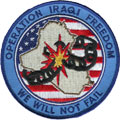 |
' Iraqi Freedom' |
| Al Udeid AB, Qatar (May of 2004 to August of 2004) | |
| This marked the squadrons first deployment after the major hostilities in Iraq seized. | |
 |
' Iraqi Freedom' |
| Balad AB, Iraq (May of 2005 to August of 2005) | |
| This was a rotation in the AEF 9/10 cycle. It was an Air National Guard rainbow deployment together with the 134th and 163rd FS. | |
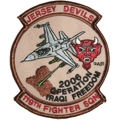 |
' Iraqi Freedom' |
| Balad AB, Iraq (September of 2006 to October of 2006) | |
| This again marked a rainbow deployment in the AEF9/10 cycle which included the 134th and 163rd FS. | |
 |
' Iraqi Freedom' |
| Balad AB, Iraq (September of 2007 to December of 2007) | |
| Rainbow deployment which included a large amount of Air National Guard squadrons - the 120th, 134th, 163rd, 186th and 188th FS. | |
 |
' Iraqi Freedom' |
| Balad AB, Iraq (May 24th, 2008 to September 17th, 2008) | |
| Rainbow deployment together with the 138th FS and the 175th FS. | |
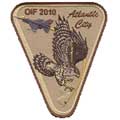 |
' Iraqi Freedom' |
| Balad AB, Iraq (December 18th, 2009 to April 5th, 2010) | |
| Deployed together with the 175th and 121st FS this time. This was the squadrons fourth deployment in SouthEast Asia. | |
 |
' Enduring Freedom' |
| Bagram AB, Afghanistan (October 13th, 2011 to April 14th, 2012) | |
| First deployment for the 119th Fighter Squadron for Operation Enduring Freedom. Although the patch to the left indicates a December to February deployment, the actual deployment was from October 2011 till April 2012. Most of the crew deployed in December. During this deployment, the squadron moved to Kandahar AB, due to runway repairs at Bagram. |
F-16 Airframe Inventory
- All 119 FS F-16s in our F-16 Aircraft Database (past and current aircraft)
- Current 119 FS F-16s in our F-16 Aircraft Database
Photos
Please use this form to add any list any error or omissions you find in the above text.
Note: your comments will be displayed immediately on this page. If you wish to send a private comment to the webmasters, please use the Contact Us link.

